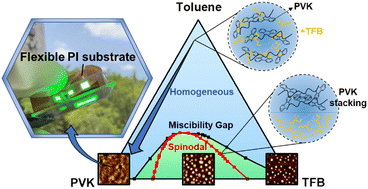Spinodal decomposition-based micro phase separation was found in a hybrid poly(9,9-dioctylfluorene-alt-N-(4-sec-butylphenyl)-diphenylamine) (TFB) and polyvinylcarbazole (PVK) system, which is used as a hole transporting layer (HTL) in atmosphere-based quantum dot (QD) light-emitting diodes (QLEDs). The micro phase separation could occur in some TFB–PVK hybrid films, leading to unexpected leakage current and poor carrier transport for the devices. A phase diagram based on the thermodynamic Flory–Huggins solution theory was established to clarify that the phase separation is based on spinodal decomposition, which is a rapid and spontaneous segregation of a single thermodynamic phase into two more stable phases without nucleation. This model clearly illustrates the hybrid TFB–PVK HTL system, showing that a hybrid polymer HTL without phase separation could significantly improve the device properties for atmosphere-based QLEDs on a glass substrate, e.g., decreased turn-on voltage by ∼47% (∼3.1 V) and increased brightness by ∼37% (∼276 000 cd m−2). Flexible atmosphere-based QLEDs with a hybrid HTL on polyimide substrates show similar results, i.e., decreased turn-on voltage by ∼30% and increased brightness by ∼133% (∼72 000 cd m−2).

